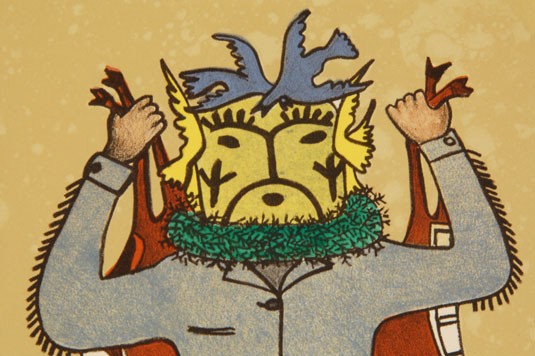Original Loloma Stone Lithograph “Qöqöle” [SOLD]
+ Add to my watchlist Forward to Friend
- Category: Original Prints
- Origin: Hopi Pueblo, Hopituh Shi-nu-mu
- Medium: stone lithograph on paper
- Size: 11-5/8” x 7” image;
14-1/4” x 9” paper;
20” x 14-1/4” framed - Item # C3838i SOLD
Charles Loloma is internationally known for his outrageously beautiful jewelry creations, but he was equally talented in making pottery and in paintings and lithography. He has often been overlooked in these latter categories, but he should not be. Multi-talented artists who are equally at ease in various mediums are not the norm. Some who come to mind are Michelangelo, Leonardo de Vinci, Allan Houser, and Charles Loloma. Of course there are others, but these stand out in most people's minds.
Stone lithography is a process by which an artist draws an image with a crayon on a large flat stone that has a smooth surface. Rosin and talc are then brushed on the image to protect and prepare it for the etching process. An acidified gum Arabic solution is then spread over the image. It reacts with the crayon to produce a “grease reservoir” which will accept the ink in the printing process. In the surface areas where there is no crayon, the solution leaves a water absorbent gum jacket which resists ink. After processing, the printer washes out the crayon with a solvent and rolls printing ink over the image.
In a print of more than one color, such as this one, each different colored element is drawn on a separate stone. The colors which combine to create the final lithograph are printed one at a time. The alignment of each of these colors is controlled print after print by hand and eye.
At the end of the printing process, the stone is ground to remove the image so that no other can ever be made and so that the stone can be used for another subject.
The subject of this lithograph, “Qöqöle,” is a Hopi Katsina. Barton Wright states "He (Qöqöle) comes in a large group of many Qöqöle and their manas, on the last day of the (Soyal) ceremony. Combining ritual with pleasure they burlesque other ceremonies while at the same time managing to 'open' the kivas. Thus it is possible that at one moment the kachina may be very seriously marking the four sides of the kivas to allow the other kachinas to come and visit the village, and at the next moment be kneeling on the ground to shoot marbles. Frequently they imitate the women's dances of the preceding fall." - Barton Wright, 1973
At Third Mesa (Hopi Pueblo) villages the Qöqöle wear old cast off Anglo clothing as shown in this lithograph. At Second Mesa villages, they wear the buckskin clothing that is traditional. The katsina face could appear in any of the six colors of the six directions because this is a directional katsina.
 This lithograph was begun on October 9, 1980 and completed on December 31, 1980. It was printed at Southwest Graphics Workshop of Scottsdale, Arizona. It was printed on Arches buff paper in six colors. There were 100 copies printed in the numbered edition. There were also 3 Studio Impressions. This is number 1 of the Studio Impressions. It is signed in lower right and numbered in lower left. Official documentation is included with the lithograph.
This lithograph was begun on October 9, 1980 and completed on December 31, 1980. It was printed at Southwest Graphics Workshop of Scottsdale, Arizona. It was printed on Arches buff paper in six colors. There were 100 copies printed in the numbered edition. There were also 3 Studio Impressions. This is number 1 of the Studio Impressions. It is signed in lower right and numbered in lower left. Official documentation is included with the lithograph.
Condition: original condition and mounted such that the full paper is visible.
Provenance: from a gentleman from Colorado
Reference: Kachinas—a Hopi Artist’s Documentary by Barton Wright with Original Paintings by Cliff Bahnimptewa

- Category: Original Prints
- Origin: Hopi Pueblo, Hopituh Shi-nu-mu
- Medium: stone lithograph on paper
- Size: 11-5/8” x 7” image;
14-1/4” x 9” paper;
20” x 14-1/4” framed - Item # C3838i SOLD



